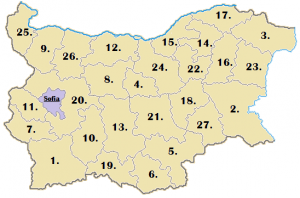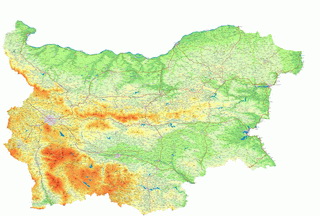Administrative divisions
Bulgaria (/bʌlˈɡɛəriə, bʊl-/ (About this soundlisten); Bulgarian: България, romanized: Balgariya), officially the Republic of Bulgaria (Bulgarian: Република България, romanized: Republika Balgariya, IPA: [rɛˈpublikɐ bɐɫˈɡarijɐ]), is a country in Southeast Europe. It is bordered by Romania to the north, Serbia and North Macedonia to the west, Greece and Turkey to the south, and the Black Sea to the east. The capital and largest city is Sofia; other major cities are Plovdiv, Varna and Burgas. With a territory of 110,994 square kilometres (42,855 sq mi), Bulgaria is Europe’s sixteenth-largest country.
One of the earliest societies in the lands of modern-day Bulgaria was the Neolithic Karanovo culture, which dates back to 6,500 BC. In the 6th to 3rd century BC the region was a battleground for ancient Thracians, Persians, Celts and Macedonians; stability came when the Roman Empire conquered the region in AD 45. The Eastern Roman Empire lost some of these territories to the numerous early Slavs. They were invaded by small number of warlike Bulgars in the late 7th century who subdued the Slavs and founded there the First Bulgarian Empire in AD 681. It dominated most of the Balkans and significantly influenced Slavic cultures by developing the Cyrillic script. This state lasted until the early 11th century, when Byzantine emperor Basil II conquered and dismantled it. A successful Bulgarian revolt in 1185 established a Second Bulgarian Empire, which reached its apex under Ivan Asen II of Bulgaria (1218–1241). After numerous exhausting wars and feudal strife, the empire disintegrated in 1396 and fell under Ottoman rule for nearly five centuries.
The Russo-Turkish War of 1877–78 resulted in the formation of the third and current Bulgarian state. Many ethnic Bulgarians were left outside the new nation’s borders, which stoked irredentist sentiments that led to several conflicts with its neighbours and alliances with Germany in both world wars. In 1946 Bulgaria came under the Soviet-led Eastern Bloc and became a one-party socialist state. The ruling Communist Party gave up its monopoly on power after the revolutions of 1989 and allowed multiparty elections. Bulgaria then transitioned into a democracy and a market-based economy. Since adopting a democratic constitution in 1991, Bulgaria has been a unitary parliamentary republic composed of 28 provinces, with a high degree of political, administrative, and economic centralisation.
Bulgaria is a member of the European Union, NATO, and the Council of Europe; it is a founding state of the Organization for Security and Co-operation in Europe (OSCE) and has taken a seat on the United Nations Security Council three times. Its market economy is part of the European Single Market and mostly relies on services, followed by industry—especially machine building and mining—and agriculture. Bulgaria is a developing country with an upper-middle-income economy, very high Human Development Index; although it has the lowest GDP per capita and joint-lowest Human Development Index in the European Union. Widespread corruption is a major socioeconomic issue; Bulgaria ranked as the most corrupt country in the European Union in 2018.[8] The country also faces a demographic crisis, with its population shrinking annually since the late 1980s; it currently numbers roughly seven million, down from a peak of nearly nine million in 1988.
Bulgaria is a unitary state. Since the 1880s, the number of territorial management units has varied from seven to 26. Between 1987 and 1999 the administrative structure consisted of nine provinces (oblasti, singular oblast). A new administrative structure was adopted in parallel with the decentralization of the economic system.[176] It includes 27 provinces and a metropolitan capital province (Sofia-Grad). All areas take their names from their respective capital cities. The provinces are subdivided into 265 municipalities. Municipalities are run by mayors, who are elected to four-year terms, and by directly elected municipal councils. Bulgaria is a highly centralized state where the Council of Ministers directly appoints regional governors and all provinces and municipalities are heavily dependent on it for funding.

Blagoevgrad
Burgas
Dobrich
Gabrovo
Haskovo
Kardzhali
Kyustendil
Lovech
Montana
Pazardzhik
Pernik
Pleven
Plovdiv
Razgrad
Ruse
Shumen
Silistra
Sliven
Smolyan
Sofia Province
Stara Zagora
Targovishte
Varna
Veliko Tarnovo
Vidin
Vratsa
Yambol
source: en.wikipedia.org
